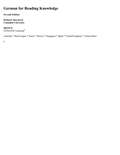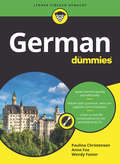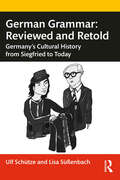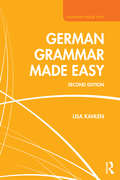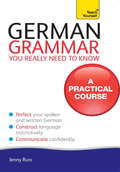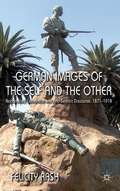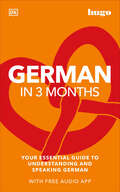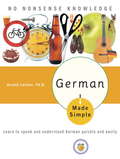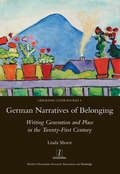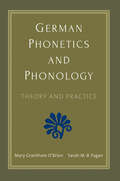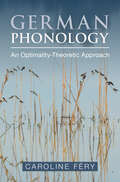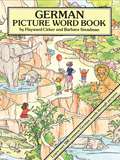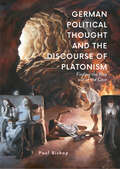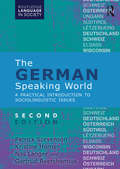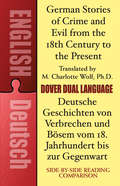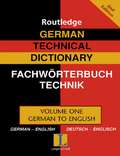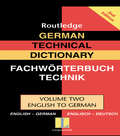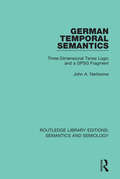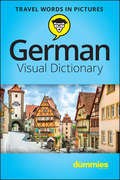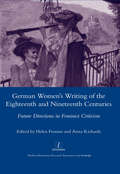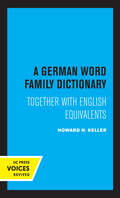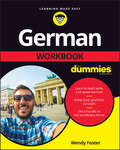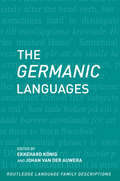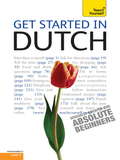- Table View
- List View
German for Reading Knowledge
by Richard KorbLearn to apply basic German grammar and vocabulary to reading and translating progressively complex texts with the seventh edition of JANNACH'S GERMAN FOR READING KNOWLEDGE. Recognized as the leader in teaching reading skills, this text provides the tools you need to read specialized literature in your field. The Book Companion Website contains the readings that appear in each chapter, plus new comprehension questions and activities about the readings that are designed to let you practice specific reading skills.
German für Dummies (Für Dummies)
by Paulina Christensen Anne Fox Wendy Forster"German für Dummies" bietet einen leichten Einstieg in die deutsche Sprache. Das Buch ist in Englisch geschrieben. Hier lernen Sie alles Wissenswerte zur Grammatik und zur Konjugation der Verben. Mit kleinen Übungen können Sie das Erlernte festigen. Im Mini-Wörterbuch finden Sie die wichtigsten Vokabeln. Und die beiliegende CD mit Dialogbeispielen aus dem richtigen Leben hilft Ihnen, die Aussprache zu erlernen.
German Grammar: Germany’s Cultural History from Siegfried to Today
by Ulf Schütze Lisa SüßenbachGerman Grammar: Reviewed and Retold is a user-friendly grammar/workbook designed to give German learners a great basis to build an in-depth knowledge of spoken and written German. Bridging the gap between grammar, storytelling, and culture, learners of the German language discover Germany’s cultural history as well as life in Germany today, while absorbing grammatical structures through reading and practice. This grammar is based on recent Second Language Acquisition (SLA) research and word frequency, to embed vocabulary and grammar into a language-specific cultural context. A key component of this approach is consistency and relevance, enabling students to apply grammatical structures to their language learning, as well as talking about the past, present, and future. Aimed at ACTFL levels Novice (all) to Intermediate (middle)/CEFR A1 to B1, this is the perfect grammar for post-beginners, combining storytelling with grammar acquisition.
German Grammar Made Easy (Grammar Made Easy)
by Lisa KahlenGerman Grammar Made Easy is the ideal introduction to the basics of German grammar for anyone new to the language or looking to refresh their knowledge. The Grammar features: • concise and jargon-free explanations supported by examples • exercises throughout to reinforce learning • a "fast-track" option for more advanced learners • a full answer key, making the Grammar ideal for self-study. A companion website is available at http://cw.routledge.com/textbooks/9781138120525/ With over 200 additional exercises and audio, it provides ample grammar practice for learners as well as the opportunity to practise listening and pronunciation skills. German Grammar Made Easy presents the essential patterns and rules of the German language in a clear and accessible manner. It is the ideal Grammar for those wishing to supplement their learning and move beyond the phrasebook level.
German Grammar You Really Need To Know: Teach Yourself
by Jenny RussComprehensive and clear explanations of key grammar patterns and structures are reinforced and contextualized through authentic materials. You will not only learn how to construct grammar correctly, but when and where to use it so you sound natural and appropriate. German Grammar You Really Need to Know will help you gain the intuition you need to become a confident communicator in your new language.
German Grammar You Really Need To Know: Teach Yourself
by Jenny RussComprehensive and clear explanations of key grammar patterns and structures are reinforced and contextualized through authentic materials. You will not only learn how to construct grammar correctly, but when and where to use it so you sound natural and appropriate. German Grammar You Really Need to Know will help you gain the intuition you need to become a confident communicator in your new language.
German Images of the Self and the Other
by Felicity RashThis book provides a detailed linguistic analysis of the nationalist discourses of the German Second Reich, which most effectively demonstrate the contrasting images of the German Self and its various Others, such as Jews, native Africans, gypsies and the enemy Other during the First World War.
German in 3 Months with Free Audio App: Your Essential Guide to Understanding and Speaking German (DK Hugo in 3 Months Language Learning Courses)
by DKTransform your German language skills in 3 months! Visiting Germany or simply want to learn a second or third language? Then this language guidebook is for you. Discover German vocabulary, grammar, and language learning tips in this self-study language learning course. The included audio app ensures you hear the language as you learn!Inside this German language book, you&’ll find: • &“Imitated pronunciation&” sections that make unfamiliar German sounds less daunting to English learners • Word lists, key phrases and model sentences that build vocabulary • Three self-assessment sections that allow the learner to engage with their own learning, and exercises follow each grammar lesson, reinforcing what has just been taught • Includes two mini bilingual dictionaries, meaning you can check words in both English and German Complete beginner or want to refresh your knowledge? Hugo: German in Three Months will have you speaking German fluently in just 12 weeks. With a fresh new look and an accompanying audio app, the latest edition of this classic self-study course provides all the resources needed to speak, read and write in German.The 12 weekly chapters contain lessons on the key grammatical structures and present a range of useful vocabulary, along with exercises to reinforce your learning. The essentials of German grammar are clearly explained and tested in conversational exercises, giving you the authentic feel of the language. In addition to a written &“imitated pronunciation&” guide, which replaces German sounds with English syllables you&’re already familiar with, the new audio app also allows you to perfect your pronunciation – at home or on the go.Whether you&’re learning a new language for work, a future vacation or as a hobby, the Hugo language course series is the perfect place to start. Learn languages like French, Dutch, Italian or Spanish in only 12 weeks! Each course includes an audio app to help with understanding and pronunciation. Language learning has never been so easy!
German Made Simple: Learn to speak and understand German quickly and easily (Made Simple)
by Arnold LeitnerLearning German Has Never Been Easier! Whether you are studying the language in school, planning a trip to Germany or Austria, or trying to learn the basics of the language closest to English, German Made Simple is the perfect book for any self-learner. Void of all nonessentials and refreshingly easy to understand, German Made Simple includes:• Basics of German grammar• Modern German vocabulary• German pronunciation guide• German reading exercises• German economic information• Common German expressions• Review exercises• Complete answer key• German-English dictionary
German Narratives of Belonging: Writing Generation and Place in the Twenty-First Century
by Linda ShorttSince unification, German culture has experienced a boom in discourses on generation, family and place. Linda Shortt reads this as symptomatic of a wider quest for belonging that mobilises attachment to counter the effects of post-modern deterritorialisation and globalisation. Investigating twenty-first century narratives of belonging by Reinhard Jirgl, Christoph Hein, Angelika Overath, Florian Illies, Juli Zeh, Stephan Wackwitz, Uwe Timm and Peter Schneider, Shortt examines how the desire to belong is repeatedly unsettled by disturbances of lineage and tradition. In this way, she combines an analysis of supermodernity with an enquiry into German memory contests on the National Socialist era, 1968 and 1989 that continue to shape identity in the Berlin Republic. Exploring a spectrum of narratives that range from agitated disavowals of place to romances of belonging, this study illuminates the topography of belonging in contemporary Germany.
German Phonetics and Phonology: Theory and Practice
by Prof. Mary Grantham O'Brien Prof. Sarah M. FaganThe first course book designed to engage students in the pronunciation of modern German by grounding practice in theory An essential introduction to the pronunciation of modern German, this unique classroom text is designed to help mid- to upper-level undergraduate students of German produce more accurate and comprehensible German speech. Written in English in a clear and engaging style and employing a minimum of technical jargon, it is the first German phonetics and phonology text to focus on theory and practice, covering topics ranging from the analysis of one's own speech to historical developments and regional variation. This work includes a wealth of exercises supported by an ancillary website audio program designed to help students perceive and produce sounds and prosodic features more accurately. Addressing topics such as word stress, sentence stress, and intonation as well as the pronunciation of individual sounds, this one-of-a-kind primer provides its users with a solid basis in German phonetics and phonology in order to improve their pronunciation of German.
German Phonology: An Optimality-Theoretic Approach
by Caroline FéryDrawing on an optimality-theoretic framework, this book provides a comprehensive overview of the phonology of German, with its idiosyncratic array of sound patterns. It starts with the consonants and vowels and the distinctive features they consist of, moving on to account for allophonic changes in detail, as well as syllables and their weight units. Phonological processes are then explored in depth, with chapter-length explorations of feet, prosodic words, prosodic phrases, and intonation phrases, showing that the prosodic hierarchy provides the domains of most phonological processes. It also includes discussions of the interfaces of morphology and syntax with phonology, as well as prosodic phrasing and intonation. The constraint-based approach allows a new holistic perspective, simultaneously encompassing all aspects of German phonology. Wide-ranging yet accessible, it is essential reading for advanced students of both linguistics and German, as well as individual scholars seeking a one-stop resource on the topic.
German Picture Word Book
by Barbara Steadman Hayward CirkerHere's a pleasant and effective way for students of German to build and strengthen vocabulary skills. The book consists of 15 carefully rendered scenes -- 14 double-page and one single-page -- each devoted to a different theme of topic: Im Zoo (At the Zoo); Das Wohnzimmer (Living Room); Auf dern Bauernhof (On the Farm); Das Badezimmer (Bathroom); Das Schlafzimmer des Mädchens (Girl's Bedroom); Beim Abendessen (At Dinner); Das Schlafzimmer des Jungens (Boy's Bedroom); Der Supermarkt (Supermarket); Das Klassenzimmer (Classroom); Am Strand (At the Beach); and 5 more.Each illustration contains dozens of common objects, clearly labeled in German. By studying the illustrations, students can learn over 500 words for common household items, clothing, foods, vehicles, furniture, names of animals, parts of the body, types of stores and public buildings, and many more.To help reinforce words and meanings, all the scenes in this book are ideal for coloring. In addition, a complete list of German words (with definite articles) and English translations will be found at the back of the book. The result is an attractive and useful language resource that will appeal to any student of basic German, child or adult.
German Political Thought and the Discourse of Platonism: Finding the Way Out of the Cave
by Paul BishopTaking Plato’s allegory of the cave as its starting-point, this book demonstrates how later European thinkers can be read as a reaction and a response to key aspects of this allegory and its discourse of enchainment and liberation. Focusing on key thinkers in the tradition of European (and specifically German) political thought including Kant, Marx, Hegel, Nietzsche, Heidegger, and the Frankfurt School, it relates them back to such foundational figures as Rousseau, Aristotle, and in particular Plato. All these thinkers are considered in relation to key passages from their major works, accompanied by an explanatory commentary which seeks to follow a conceptual and imagistic thread through the labyrinth of these complex, yet fascinating, texts. This book will appeal in particular to scholars of political theory, philosophy, and German language and culture.
The German-Speaking World: A Practical Introduction to Sociolinguistic Issues (Routledge Language In Society Ser.)
by Patrick Stevenson Gertrud Reershemius Kristine Horner Nils LangerThe German-Speaking World is an accessible textbook that offers students the opportunity to explore for themselves a wide range of sociolinguistic issues relating to the German language and its role in the world. This new, second edition has been fully revised to reflect the many political and social changes of the last 20 years including the impact of technology on language change. It continues to combine text with practical exercises and discussion questions to stimulate readers to think for themselves and to tackle specific problems. Key features of this book: Informative and comprehensive: covers a wide range of current issues Practical: contains a variety of graded exercises and tasks plus an index of terms Topical and contemporary: deals with current situations and provides up-to-date illustrative material Thought-provoking: encourages students to reflect and research for themselves The German-Speaking World is the ideal textbook for undergraduate students who have a sound practical knowledge of German but who have little or no knowledge of linguistics or sociolinguistics.
German Stories of Crime and Evil from the 18th Century to the Present / Deutsche Geschichten von Verbrechen und Bösem vom 18. Jahrhundert bis zur Gegenwart: A Dual-Language Book (Dover Dual Language German)
by Prof. M. Charlotte WolfIdeal for students of German as well as crime story enthusiasts, this dual-language edition contains ten short stories. Selections range from eighteenth- and nineteenth-century classics by Friedrich Schiller ("Der Verbrecher aus verlorener Ehre"/"The Criminal of Lost Honor") and Willibald Alexis ("Das Gelöbnis der drei Diebe"/"The Pledge of the Three Thieves") to tales by such popular contemporary authors as Iris Klockmann ("Der Kuss des Todes"/"The Kiss of Death") and Karin Holz ("Der letzte Stich"/"The Last Trick").Appropriate for intermediate-level students of German, this volume is equally suited to classroom use and independent study. New English translations appear on pages facing the original German text. The editor provides an overview of German crime fiction in addition to concise introductions to each story.
German Technical Dictionary: Universal-worterbuch Der Technik Englisch (Routledge Bilingual Specialist Dictionaries Ser.)
by RoutledgeSince its publication in 1995, the German Technical Dictionary has established itself as the definitive resource for anyone who needs to translate technical documents between German and English.This new edition has been substantially revised to reflect the technological environment of the twenty-first century. The revised edition contains over 75,000 entries, of which over 5,000 are new, with many new entries in the areas of:* the Internet and telecommunications* bio-technology and the new genetics* new developments in health technology.Throughout, this dictionary continues to benefit from the features that made the first edition so valuable, including accurate translations in British and American English and an attractive, durable and easy to use layout.
German Technical Dictionary (Volume 2)
by RoutledgeSince its publication in 1995, the German Technical Dictionary has established itself as the definitive resource for anyone who needs to translate technical documents between German and English. This new edition has been substantially revised to reflect the technological environment of the 21st century. The revised edition contains over 75,000 entries, of which over 5,000 are new, with many new entries in the areas of: * the internet and telecommunications * bio-technology and the new genetics * new developments in health technology Throughout this dictionary continues to benefit from the features that made the first edition so valuable, including accurate translations in British and American English and an attractive, durable and easy to use layout.
German Temporal Semantics: Three-Dimensional Tense Logic and a GPSG Fragment (Routledge Library Editions: Semantics and Semiology #10)
by John A. NerbonneFirst published in 1985, this book analyses temporal meaning in German. The framework is that of a model-theoretic semantics, more specifically one incorporating a multi-dimensional tense logic. The first chapter presents this logic and argues that three dimensions are optimal for the description of natural language temporalia. The second chapter applies this theory to the analysis of temporal meaning in German. Frame adverbials, the Present and Past Tenses, duratives, aspectual adverbials using in, and the adverbials particle schon are examined. Chapter 3 provides a formal syntax to bear the semantic analysis proposed in the second chapter and the final chapter explores syntactic and semantic extensions of the fragment, showing how the Perfect, the particle noch, the passive, and a distinct reading of frame adverbials may be accommodated.
German Visual Dictionary For Dummies
by Consumer DummiesGerman Visual Dictionary A visual way to learn GermanIt’s a fact—seeing something helps us remember it. This handy guide helps you build your German vocabulary with full-color pictures that illustrate the words. You’ll be able to communicate with native speakers faster as you learn and remember more words and their meanings. The book is organized by themes such as transportation, accommodations, restaurants and eating, sports, emergencies, shopping, and more, making it especially useful for travelers. Boost your learning speed today!InsideNavigate a cityHandle money like a localMaster short conversationsBe prepared for emergencies
German Women's Writing of the Eighteenth and Nineteenth Centuries: Future Directions in Feminist Criticism
by Helen FroniusGerman women writers of the eighteenth and nineteenth centuries have been the subject of feminist literary critical and historical studies for around thirty years. This volume, with contributions from an international group of scholars, takes stock of what feminist literary criticism has achieved in that time and reflects on future trends in the field. Offering both theoretical perspectives and individual case studies, the contributors grapple with the difficulties of appraising 'non-feminist' women writers and genres from a feminist perspective and present innovative approaches to research in early women's writing. This inclusive and cross- disciplinary collection of essays will enrich the study of German women's writing of the eighteenth and nineteenth centuries and contribute to contemporary debates in feminist literary criticism. Anna Richards is Lecturer in German at Birkbeck College, University of London. Helen Fronius is College Lecturer in German at Keble College, University of Oxford.
A German Word Family Dictionary: Together with English Equivalents
by Howard H. KellerThis title is part of UC Press's Voices Revived program, which commemorates University of California Press’s mission to seek out and cultivate the brightest minds and give them voice, reach, and impact. Drawing on a backlist dating to 1893, Voices Revived makes high-quality, peer-reviewed scholarship accessible once again using print-on-demand technology. This title was originally published in 1978.
German Workbook For Dummies
by Wendy FosterSprechen sie Deutsch? Learn this fun language with Dummies German Workbook For Dummies is for German beginners who want to get started learning the official language of 7 countries. Packed with foundational grammar and integrated vocab, German Workbook For Dummies will set new language learners on their way to an exciting experience learning this complex language. Inside, you'll find plenty of practice for an experience that supports how people learn languages most effectively. As you make your way through the workbook, your confidence will grow as you discover how to handle greetings and introductions, make small talk, and understand daily encounters... auf Deutsch! Practice your speaking and writing skills in German Grasp the basics of German grammar Learn functional vocabulary and common slang Complete exercises and activities to build your confidenceWith a little help from Dummies, you'll excel in your German studies.
The Germanic Languages (Routledge Language Family Series)
by Ekkehard Konig Johan van der AuweraProvides a unique, up-to-date survey of twelve Germanic languages from English and German to Faroese and Yiddish.
Get Started in Beginner's Dutch: Teach Yourself
by Gerdi Quist Dennis StrikThis product is most effective when used in conjunction with the corresponding audio support.- You can purchase the book and audio support as a pack (ISBN: 9781444105568)- The audio support is also sold separately (ISBN: 9781444105575)(copy and paste the ISBN number into the search bar to find these products)Are you looking for a course in Dutch written for the absolute beginner who has no experience of learning a foreign language? Get Started in Dutch will give you the confidence to communicate in Dutch.Now fully updated to make your language learning experience fun and interactive. You can still rely on the benefits of a top language teacher and our years of teaching experience, but now with added learning features within the course and online. The emphasis of the course is placed on communication, rather than grammar, and all the teaching is in English, so that you will quickly and effortlessly get started in Dutch. By the end of this course, you will be at Level B1 of the Common European Framework for Languages: can deal with most situations likely to arise whilst travelling in an area where the language is spoken. Learn effortlessly with new, easy-to-read page design and interactive features: NOT GOT MUCH TIME?One, five and ten-minute introductions to key principles to get you started.AUTHOR INSIGHTSLots of instant help with common problems and quick tips for success, based on the author's many years of experience.USEFUL VOCABULARYEasy to find and learn, to build a solid foundation for speaking.DIALOGUESRead and listen to everyday dialogues to help you speak and understand fast.PRONUNCIATIONDon't sound like a tourist! Perfect your pronunciation before you go.TEST YOURSELFTests in the book and online to keep track of your progress.EXTEND YOUR KNOWLEDGEExtra online articles at: www.teachyourself.com to give you a richer understanding of culture and history TRY THISInnovative exercises illustrate what you've learnt and how to use it.
